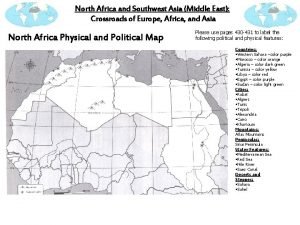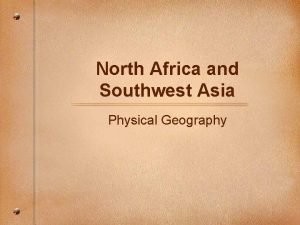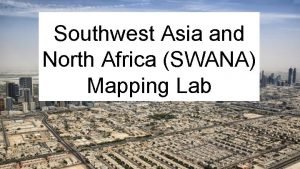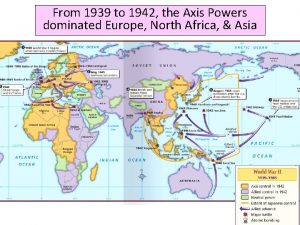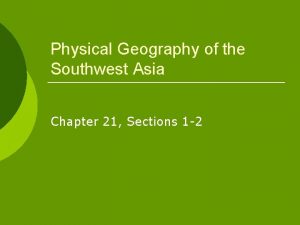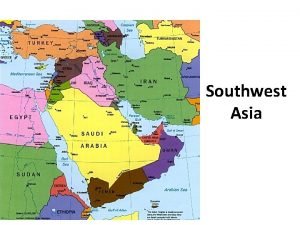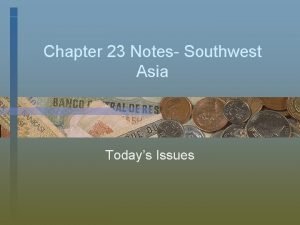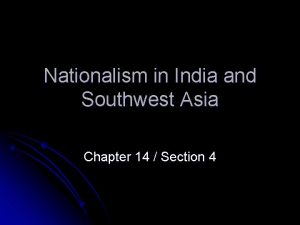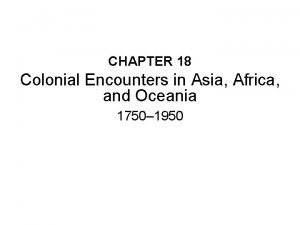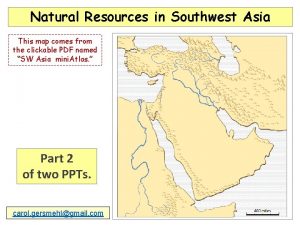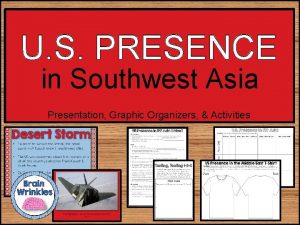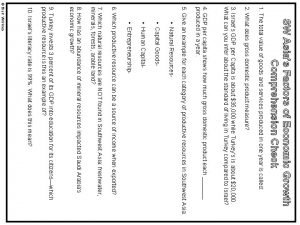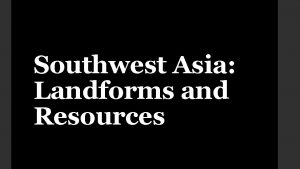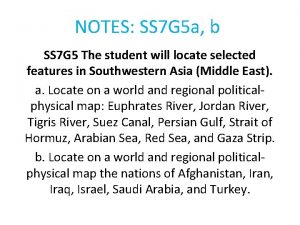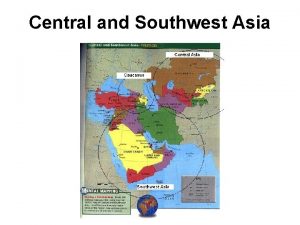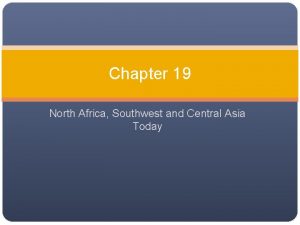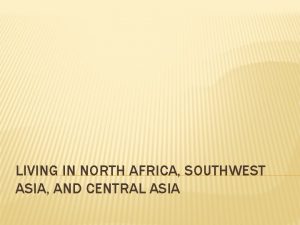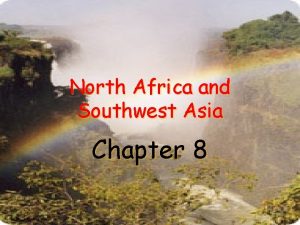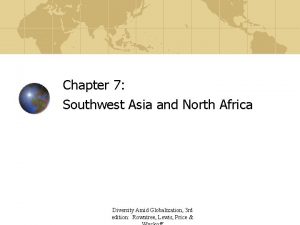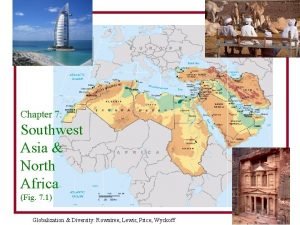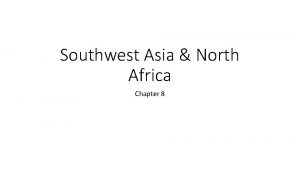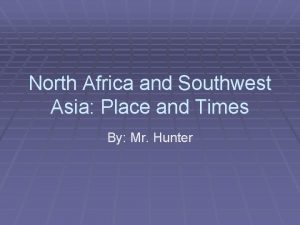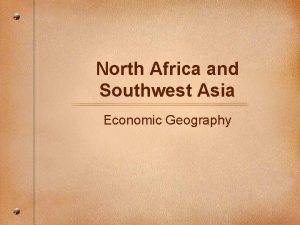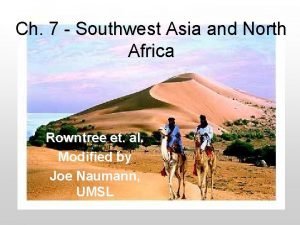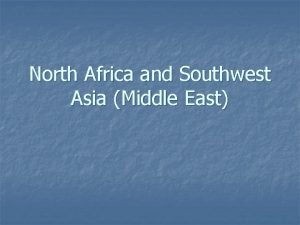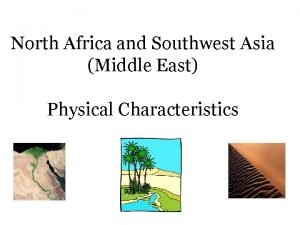Chapter 17 North Africa Southwest Asia and Central





























- Slides: 29

Chapter 17 North Africa, Southwest Asia and Central Asia


Chapter Objectives �Describe the major landforms and natural resources of North Africa, Southwest Asia, and Central Asia. �Discuss the climate and vegetation of North Africa, Southwest Asia, and Central Asia.

The Land Section 1

Section Objectives �Identify which land water features dominate the region. �Discuss how the region’s major rivers are important to its people. �Explain why much of the world is economically dependent on the region.

Terms to Know �alluvial soil �wadi �kum �phosphate

A Geographic View

Geographic LIteracy The Nile River, flowing through northeastern Africa to the Mediterranean Sea, keeps Egypt from being entirely desert. For centuries, the Nile flooded its banks every summer, covering nearby fields with fertile soil. Dams, especially the Aswan High Dam, now control Nile flooding, drastically reducing sediment deposits and fertility.

Seas and Peninsulas �North Africa, Southwest Asia, and Central Asia feature numerous seas and peninsulas. �These include the Mediterranean, Red, and Black Seas as well as the Arabian and Sinai Peninsulas. �The Dead Sea, the Caspian Sea, and the Aral Sea are actually landlocked bodies of salt water. �The Aral Sea, which began to dry up when the Soviet Union diverted river source waters for irrigation, seems to be coming back.

Rivers �Major Rivers: Cradles of Civilization �The Nile River Valley provides water and a lush, fertile living space for about 90 percent of Egypt’s population. �The Tigris and Euphrates Rivers help irrigate farms throughout Syria, Turkey, and Iraq. �Streambeds Runoff from infrequent, violent rainstorms creates temporary streams in arid North Africa and Southwest Asia.

Rivers

Plains, Plateaus and Mountains �Coastal Plains Although most of the region is made up of deserts and mountains, the coastal plains along the Mediterranean provide the agricultural base of the region. �Highland �Enough precipitation falls on the Atlas Mountains of North Africa to make them hospitable to settlement and farming. �The Asir Mountains of the Arabian Peninsula are also agriculturally productive. �The Caucasus Mountains between the Black Sea and the Caspian Sea are known for their grandeur and beauty.

Plains, Plateaus and Mountains

Earthquakes � The shifting tectonic plates of the region have built mountains, shifted landmasses, and caused earthquakes. A 1999 earthquake in Turkey measured 7. 4 on the Richter scale, toppling more than 76, 000 buildings and killing nearly 20, 000 people.

Earthquakes

Natural Resources �Oil and Natural Gas About 70 percent of the world’s oil reserves and 33 percent of the world’s natural gas reserves are found in the region. �Minerals Turkmenistan has the world’s largest deposits of sulfate. Morocco ranks third in the production of phosphate. �The region may contain up to 10 percent of the world’s iron ore reserves. �Building Diverse Economies Many countries in the region are diversifying their economies so that they are not so dependent on their oil and mineral exports.

Climate and Vegetation Section 2

Section Objectives �Explain how the climates of the region differ. �Describe how the needs of a growing population have affected the natural vegetation of the region.

Terms to Know �Oasis �pastoralism �cereal

A Geographic View

Geographic Literacy �Because the coastal city of Agadir in Morocco has 300 days of sunshine per year, its beaches are a popular tourist attraction, as are other Moroccan beaches along the Atlantic Ocean and the Mediterranean Sea.

Water: A Precious Resource �Rainfall is plentiful in some parts of North Africa, Southwest Asia, and Central Asia, but in most places water is scarce. �Desert Climate Desert areas, such as North Africa’s Sahara, cover almost 50 percent of the region. �In the deserts, summers are long and hot, winters are cold, the land is mostly flat, and precipitation averages about 10 inches (25 cm) per year.

Water: A Precious Resource �Steppe Climate Steppe is the second-largest climate region. �Semi-arid conditions with light precipitation support short grasses that are grazed by livestock.

Climatic Variations � Exports and Tourists The Mediterranean climate region features cool, rainy winters and hot, dry summers. � This fertile area exports citrus fruits, olives, and grapes to Europe and the United States. � Tourism is an important industry.

Climactic Variations

Climatic Variations � Rainfall Receiving plenty of rainfall, highlands areas support forests and grain crops without irrigation. � A Sign of Things to Come? Climate changes have turned some grassy plains in the region into deserts.

Climatic Variations

Section 1 - Summary � North Africa, Southwest Asia, and Central Asia are located at the crossroads of Asia, Africa, and Europe. �The region is a jigsaw puzzle of peninsulas and seas. �Rivers feed the inland seas and supply irrigation to parched lands. Their alluvial soil deposits enrich the land, especially in the Nile River Valley and delta. �The movement of tectonic plates forms mountains, moves landforms, and causes earthquakes in the region. �The region contains much of the world’s oil and natural gas reserves.

Section 2 - Summary �Rainfall in North Africa, Southwest Asia, and Central Asia varies widely. Most of the region contains arid areas. �The four climate regions in North Africa, Southwest Asia, and Central Asia are desert, steppe, Mediterranean, and highlands. �Natural vegetation in the region varies widely and is closely related to rainfall and irrigation patterns.
 South west asia and north africa map
South west asia and north africa map Southwest asia/north africa (swana) political map
Southwest asia/north africa (swana) political map North africa and southwest asia physical geography
North africa and southwest asia physical geography Southwest asia and north africa physical map
Southwest asia and north africa physical map North africa and southwest asia mountains
North africa and southwest asia mountains Physical map of swana
Physical map of swana Goodguysww.
Goodguysww. Asia africa europe north america south america
Asia africa europe north america south america Chapter 22 human geography of southwest asia
Chapter 22 human geography of southwest asia Map of southwest asia
Map of southwest asia Chapter 21 physical geography of southwest asia
Chapter 21 physical geography of southwest asia Chapter 23 today's issues southwest asia
Chapter 23 today's issues southwest asia Nationalism in india and southwest asia
Nationalism in india and southwest asia Judaism vs islam chart
Judaism vs islam chart Nationalism in india and southwest asia
Nationalism in india and southwest asia Nationalism in india and southwest asia
Nationalism in india and southwest asia Chapter 18 colonial encounters in asia and africa
Chapter 18 colonial encounters in asia and africa Brain wrinkles southwest asia
Brain wrinkles southwest asia Chapter 21 section 1 landforms and resources answer key
Chapter 21 section 1 landforms and resources answer key Natural resources in southwest asia
Natural resources in southwest asia Relative location of southwest asia
Relative location of southwest asia Southwest asia hearth
Southwest asia hearth Brain wrinkles southwest asia answer key
Brain wrinkles southwest asia answer key Voluntary trade comprehension check
Voluntary trade comprehension check Se asian economies comprehension check answer key
Se asian economies comprehension check answer key Kurdish coat of arms
Kurdish coat of arms Southwest asia landforms
Southwest asia landforms Jordan river southwest asia map
Jordan river southwest asia map Nationalism in southwest asia
Nationalism in southwest asia Europe partitioning in southwest asia answer key
Europe partitioning in southwest asia answer key

